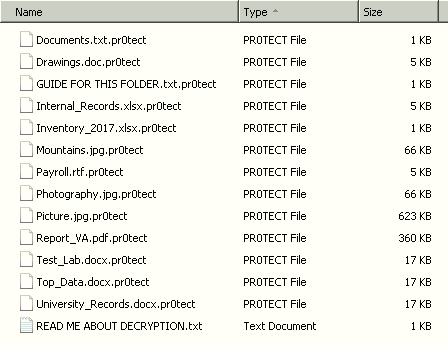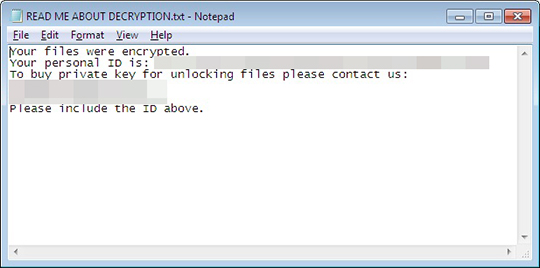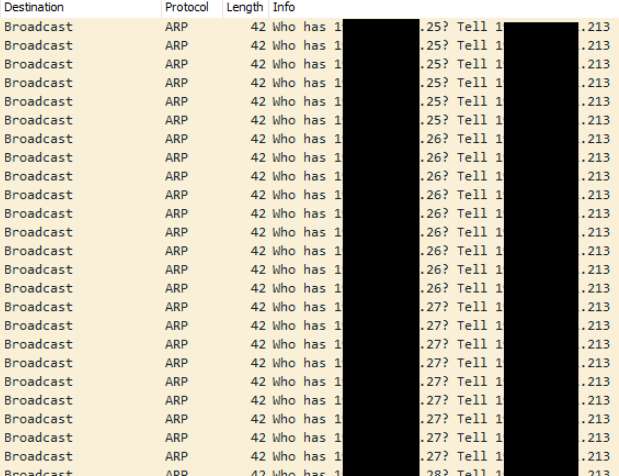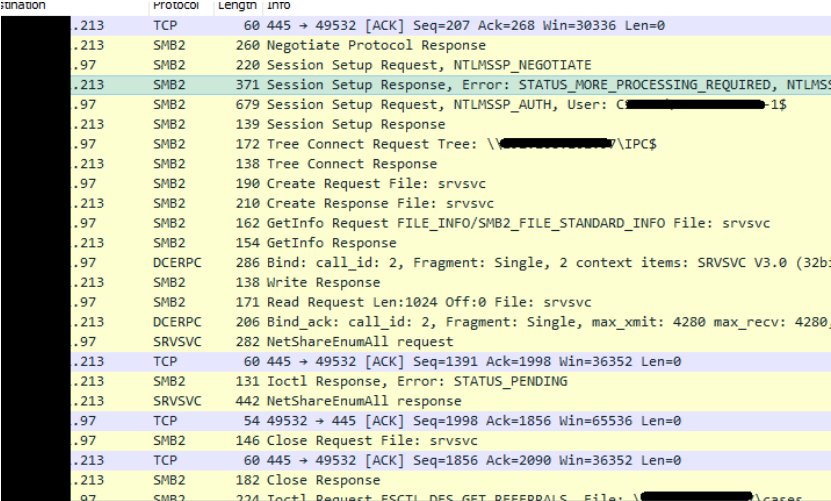by Buddy Tancio (Threats Analyst)
Fileless threats and ransomware aren’t new, but a malware that incorporates a combination of their characteristics can be dangerous. Take for instance the fileless, code-injecting ransomware we’ve uncovered—SOREBRECT, which Trend Micro detects as RANSOM_SOREBRECT.A and RANSOM_SOREBRECT.B.
We first encountered SOREBRECT during our monitoring in the beginning of second quarter this year, affecting the systems and networks of organizations in the Middle East. Extracting and analyzing the SOREBRECT samples revealed the unusual techniques it employs to encrypt its victim’s data. Its abuse of the PsExec utility is also notable; SOREBRECT’s operators apparently use it to leverage the ransomware’s code injection capability.
SOREBRECT’s stealth can pose challenges
While file encryption is SOREBRECT’s endgame, stealth is its mainstay. The ransomware’s self-destruct routine makes SOREBRECT a fileless threat. The ransomware does this by injecting code to a legitimate system process (which executes the encryption routine) before terminating its main binary. SOREBRECT also takes pains to delete the affected system’s event logs and other artifacts that can provide forensic information such as files executed on the system, including their timestamps (i.e. appcompat/shimcache and prefetch). These deletions also deter analysis and prevent SOREBRECT’s activities from being traced.
When we first saw SOREBRECT in the wild, we observed a low distribution base that was initially concentrated on Middle Eastern countries like Kuwait and Lebanon. By the start of May, however, our sensors detected SOREBRECT in Canada, China, Croatia, Italy, Japan, Mexico, Russia, Taiwan, and the U.S. Affected industries include manufacturing, technology, and telecommunications. Given ransomware’s potential impact and profitability, it wouldn’t be a surprise if SOREBRECT turns up in other parts of the world, or even in the cybercriminal underground where it can be peddled as a service.
Related Hashes:
Detected as RANSOM_SOREBRECT.A (SHA256):
Figure 1: SOREBRECT’s attack chain
SOREBRECT’s code injection makes it a fileless threat SOREBRECT’s attack chain involves the abuse of PsExec, a legitimate, Windows command-line utility that lets system administrators execute commands or run executable files on remote systems. The misuse of PsExec to install SOREBRECT indicates that administrator credentials have already been compromised, or remote machines were exposed or brute-forced. SOREBRECT isn’t the first family to misuse PsExec—SAMSAM, Petya, and its derivative, PetrWrap (RANSOM_SAMSAM and RANSOM_PETYA, respectively), for instance, use PsExec to install the ransomware on compromised servers or endpoints. SOREBRECT takes this a notch further by maliciously deploying PsExec and performing code injection. It injects its code into Windows’ svchost.exe process, while the main binary self-destructs. The combination is potent: once the deployed ransomware binary finishes execution and self-termination, the injected svchost.exe—a legitimate Windows service-hosting system process—resumes the execution of the payload (file encryption). Because SOREBRECT becomes fileless after code injection, sourcing its binary sample at the endpoint level is challenging. Why PsExec? While attackers can both use Remote Desktop Protocol (RDP) and PsExec to install SOREBRECT in the affected machine, its code injection capability makes the attack more effective. Compared to using RDP, utilizing PsExec is simpler and can take advantage of SOREBRECT’s fileless and code injection capabilities. PsExec can enable attackers to run remotely executed commands, instead of providing and using an entire interactive log-in session, or manually transferring the malware into a remote machine, like in RDPs. In SOREBRECT’s case, it makes more sense for the attackers to use PsExec since once the main binary is executed, the svchost.exe process injected with malicious code can still carry out the payload. To cover its tracks, SOREBRECT also utilizes wevtutil.exe to delete the system’s event logs, and vssadmin to delete shadow copies. The svchost.exe process that was injected with malicious code executes the payload—encrypting the files of the local machine and network shares. SOREBRECT uses the Tor network protocol to anonymize its connection to its command-and-control (C&C) server. Figure 2: SOREBRECT appends encrypted files with a .pr0tect extension
Figure 2: SOREBRECT appends encrypted files with a .pr0tect extension
 Figure 3: One of SOREBRECT’s ransom notes
Figure 3: One of SOREBRECT’s ransom notes
 Figure 4: SOREBRECT’s network scanning activity to enumerate machines with open shares
Figure 4: SOREBRECT’s network scanning activity to enumerate machines with open shares
 Figure 5: SOREBRECT initiating a connection on the share on a live host
Figure 5: SOREBRECT initiating a connection on the share on a live host
- Restrict user write permissions. A significant factor that exposes network shares to ransomware is the tendency to give users full permissions. Limiting them will prevent ransomware from carrying out its file-encrypting routines across the network. Reviewing the permissions for each user in the Domain is a good starting point. This entails assessing each user account/group within the Active Directory and only providing the necessary privilege levels. Configuring the security of shared files and folders on a network is also recommended (don’t set up folders that anyone can easily access, for instance).
- Limit privilege for PsExec. PsExec is commonly used in enterprise networks, providing system administrators flexibility with how they interact with remote machines. As pointed out by its creator, however, in cybercriminals’ hands it can provide a way to interface and laterally move within remote systems using compromised credentials. This would ultimately enable them to install and propagate threats such as ransomware. Limiting and securing the use of tools and services such as PsExec and providing permission to run them only to administrator accounts that really need it help mitigate threats that misuse PsExec.
- Back up files. Cybercriminals use the potential loss of important and personal data as a fear-mongering tactic to coerce victims into paying the ransom. Organizations and end users can back up files to remove their leverage: keep at least three copies, with two stored in different devices, and another to an offsite or safe location.
- Keep the system and network updated. Ensuring that the operating system, software, and other applications are current with the latest patches deters threats from using security gaps as their doorways into the systems or networks. This has been exemplified by malware such as WannaCry, UIWIX, and Adylkuzz that exploited a vulnerability. Employing virtual patching in the absence of patches can also be considered.
- Foster a cybersecurity-aware workforce. User education and awareness helps improve everyone’s security posture. Like other malware, ransomware’s points of entry is typically through email and malicious downloads or domains. Organizations should conduct regular training to ensure that employees have a solid understanding of company security policy, procedure, and best practices.
- Deploy multilayered security mechanisms. As ransomware matures in the threat landscape, we can only expect it to diversify in terms of attack methods and targets. There is no silver bullet for ransomware, which is why enterprises need a defense-in-depth approach to security where proactive security mechanisms are arrayed. Data categorization and network segmentation help mitigate damage in case of exposure. While advanced sandboxing provides a way to quarantine and analyze unknown or dubious files, application control and behavior monitoring prevent suspicious files from executing and block unwanted modifications to the system.
PROTECTION FOR ENTERPRISES
-

Email and Gateway Protection
Trend MicroTM Cloud App Security, Trend MicroTM Deep DiscoveryTM Email Inspector and InterScanTM Web Security addresses ransomware in common delivery methods such as email and web.Spear-phishing protectionMalware sandboxingIP/Web reputation checkingDocument exploit detection
-

Endpoint Protection
Trend Micro Smart Protection Suites detects and stops suspicious behavior and exploits associated with ransomware at the endpoint level.High-fidelity machine learningRansomware behavior monitoringApplication controlVulnerability shieldingWeb security provision
-

Network Protection
Trend MicroTM Deep DiscoveryTM Inspector detects malicious traffic, communications, and other activities associated with attempts to inject ransomware into the network.Network traffic scanningMalware sandboxingLateral movement prevention
-

Server Protection
Trend MicroTM Deep SecurityTM detects and stops suspicious network activity and shields servers and applications from exploits.Web server protectionVulnerability shieldingLateral Movement Prevention
PROTECTION FOR SMALL-MEDIUM BUSINESSES AND HOME USERS
-

Protection for Small-Medium Businesses
Trend Micro Worry-FreeTM Business Security Advanced offers cloud-based email gateway security through Hosted Email Security that can detect and block ransomware.Ransomware behavior monitoringIP/Web Reputation
-

Protection for Home Users
Trend Micro Security 10 provides robust protection against ransomware by blocking malicious websites, emails, and files associated with this threat.IP/Web ReputationRansomware Protection
- 4854A0CA663588178B56754CD50626B2E8A121F66A463E1C030836E9BD5B95F8
- AC4184EEC32795E1CBF2EFC5F4E30D0CBE0B7F982BC2060C180BE432994DCEFF
- 05CEFE71615F77D9A386BF6F48AD17ACA2BAE433C95A6F2443184462832A3E90
- 36fa4c4a7bd25f086394b06fe50e41410f78dbb3
- 9f327c5168b07cec34e1b89aba5f45b78f20e753
- 4142ff4667f5b9986888bdcb2a727db6a767f78fe1d5d4ae3346365a1d70eb76
Tags


